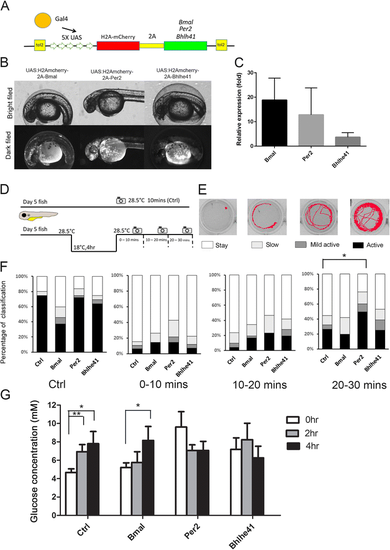- Title
-
MicroRNAs regulate gene plasticity during cold shock in zebrafish larvae
- Authors
- Hung, I.C., Hsiao, Y.C., Sun, H.S., Chen, T.M., Lee, S.J.
- Source
- Full text @ BMC Genomics

ZFIN is incorporating published figure images and captions as part of an ongoing project. Figures from some publications have not yet been curated, or are not available for display because of copyright restrictions. |

ZFIN is incorporating published figure images and captions as part of an ongoing project. Figures from some publications have not yet been curated, or are not available for display because of copyright restrictions. |
|
Overexpression of core clock gene per2 or bhlhe41 increases cold tolerance. a The design of the Gal-UAS driven circadian clock gene expression construct is shown. H2AmCherry (red) is placed upstream of clock gene (green) that will be cleaved by a 2A peptide (yellow). b 1-Cell embryos were injected with indicated plasmids and examined under bright (upper row) and dark filed (bottom row through a rhodamine filter cube). Mosaic expression of mcherry indicates the expression of bmal, per2, or bhlhe41 in 48 hpf embryos. c Normalized expression level of clock genes compared to control embryos at 5 days post fertilization by qPCR (N = 3). d Scheme of cold recovery assay at 5 days post fertilization fish. e Classifications of swimming track recorded for 10 mins. f Quantitative analysis of swimming patterns for zebrafish larva transient expressed without (control) and with designated circadian clock gene at different time periods after recording. g Glucose concentration were measured in 4 dpf zebrafish larval lysate collected at different time point after cold shock. *P ≤ 0.05, **p ≤ 0.01 |

ZFIN is incorporating published figure images and captions as part of an ongoing project. Figures from some publications have not yet been curated, or are not available for display because of copyright restrictions. PHENOTYPE:
|

